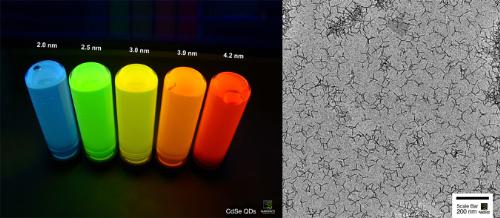Quantum Materials Corp. announced it has shipped Tetrapod Quantum Dots in sample quantities to a diversified leading Asian-based electronics manufacturer. Quantum Materials recently developed tetrapod quantum dots to meet the client's performance specifications.
Tetrapod Quantum Dots are an advanced nanoscale material that improves the performance and energy efficiency of very high-resolution computer, TV and smartphone displays. Quantum Materials' patent-pending continuous-flow technology produces uniform, narrow bandwidth tetrapod quantum dots with bright emission, less aggregation, purer colors (including high-luminous red) and precise color rendition.
 |
|
Quantum Materials Corp.'s Tetrapod Quantum Dots. (LEDinside/Quantum Materials Corp.)
|
Manufacturers are seeking to "print" tetrapod quantum dots onto backplane films in liquid crystal displays (LCD) for brighter images, larger screens and a wider gamut of colors to deliver a new visual experience in image technology. Thinner, lighter, brighter and less expensive QD-LED displays, including portable and flexible devices, will offer almost infinite contrast levels, deep black levels and high light output with no motion blur or field-of-view issues.
"Tetrapod Quantum Dots ultimately allow for lower display manufacturing costs due to their superior luminescence and much lower incidence of aggregation,” said Stephen Squires, Quantum Materials Corp's Founder and CEO. “Far fewer quantum dots are required to achieve the same level of performance."
David Doderer, VP of R&D for Quantum Materials wrote the feature article in the July/August 2013 issue of iSP Magazine entitled "Quantum Dots: The Future of Displays". The article details Quantum Materials' ability to reduce the cost of quantum dot creation while ensuring uniformity in quantities sufficient to meet high volume display-manufacturing needs.
Nanomarkets' August article "Key Quantum Dots Markets" highlighted "U.S.-based Quantum Materials Corporation" and the need for "cost-effective large-scale manufacturing techniques, which will be the key to the commercialization of cost-effective and high-performance QDs.”












